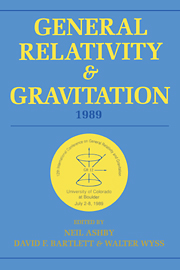 General Relativity and Gravitation, 1989
General Relativity and Gravitation, 1989 Book contents
- Frontmatter
- Contents
- Preface
- Conference committees
- Part A Classical relativity and gravitation theory
- WORKSHOPS
- A1 Exact solutions and exact properties of Einstein equations
- A2 Spinors, twistors, and complex methods
- A3 Alternative gravity theories
- A4 Asymptotia, singularities, and global structure
- A5 Radiative spacetimes and approximation methods
- A6 Algebraic computing
- A7 Numerical relativity
- Part B Relativistic astrophysics, early universe, and classical cosmology
- WORKSHOPS
- Part C Experimental gravitation and gravitational wave detection
- WORKSHOPS
- Part D Quantum gravity, superstrings, quantum cosmology
- WORKSHOPS
- Part E Overviews-past, present, and future
A4 - Asymptotia, singularities, and global structure
Published online by Cambridge University Press: 05 March 2012
- Frontmatter
- Contents
- Preface
- Conference committees
- Part A Classical relativity and gravitation theory
- WORKSHOPS
- A1 Exact solutions and exact properties of Einstein equations
- A2 Spinors, twistors, and complex methods
- A3 Alternative gravity theories
- A4 Asymptotia, singularities, and global structure
- A5 Radiative spacetimes and approximation methods
- A6 Algebraic computing
- A7 Numerical relativity
- Part B Relativistic astrophysics, early universe, and classical cosmology
- WORKSHOPS
- Part C Experimental gravitation and gravitational wave detection
- WORKSHOPS
- Part D Quantum gravity, superstrings, quantum cosmology
- WORKSHOPS
- Part E Overviews-past, present, and future
Summary
Let me organize this report by comparing some of the issues with the achievements described in the contributed papers.
Two important questions of ‘Asymptopia” are: (1) Relations between the sources and the asymptotic field of space-time, and (2) The existence and smoothness property of solutions of the field equations admitting a null infinity in the sense of Penrose. In view of its importance it is regrettable that not a single paper addressed the first question. Apparently it can still only be treated in the context of approximation methods. (Compare the workshops A5, A6.) Concerning the second question there is still no proof or counter example known.
There were however two contributions dealing with existence questions of solutions with certain asymptotic properties. Choquet-Bruhat demonstrated the existence of global solutions of the Yang-Mills Higgs equations of Anti-de Sitter space-time, under the condition that there is no radiation at timelike infinity. Reula showed - via implicit function theorem techniques - that near the Schwarzschild solution there does exist the expected number of stationary solutions of the vacuum field equations, with well defined Geroch-Hansen multipole moments. Up to now this was only known for the Weyl solutions, hence in the axisymmetric case.
The further contributions under this heading consisted mainly in extensions or refinements of already known results or approaches to certain questions. Let me mention two examples: Bičak and Schmidt extended the investigation of the global structure of boost-rotationally symmetric vacuum spacetimes.
- Type
- Chapter
- Information
- General Relativity and Gravitation, 1989Proceedings of the 12th International Conference on General Relativity and Gravitation, pp. 105 - 106Publisher: Cambridge University PressPrint publication year: 1990
